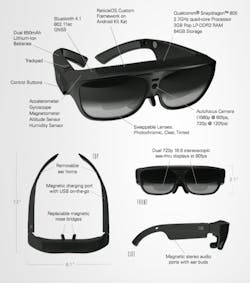Smart glasses gain in enterprise applications, surpassing Google Glass
Head-mounted devices--aka, smart glasses or head-worn displays--are seeing a resurgence, but are now driven by enterprise rather than consumer applications. Rivals are topping Google in deploying smart glasses to provide augmented reality solutions for workers in factories, distribution centers, oilfields, and more, according to a recent report from Lux Research (Boston, MA).
“As next-generation glasses such as Epson’s Moverio BT-2000 and Meta Pro emerge, the field will become even more competitive, ending a period of high premiums for hardware. Software and service will become the primary way to maintain margins,” said Tony Sun, Lux Research Analyst and lead report author. “Apple’s impact on the market will also soon be visible, as it builds on the acquisition of Metaio, a leading augmented reality software developer,” he added.
Lux identified over 70 enterprise deployments for the increasingly powerful head-mounted displays. Most are still in pilot programs but use cases can broadly be classified into three core functions: accessing information, real-time communication, and documentation. Among the findings:
• ODG R-7 is the best all-around device (see figure below). Only five glasses meet minimum performance requirements across all three broad functions. Of them, Osterhout Design Group’s ODG R-7 stands out because it is the only one on the market that does not need a wired controller and meets industrial standards for hazardous environments.
• Sony’s SmartEyeglass stands out for customer service. SmartEyeglass is the top performer for use in customer service and quality control, fulfilling two of the three broad functions--information access and real-time communication--since it is light and small, and competitively priced. Sony’s product comes a close second for warehousing, assembly, and installation, behind Meta-1, which is not yet on the market.
• Google Glass is in the game only for real-time communication. Google Glass is a truly viable option only in real-time communication applications such as online sales support. Even there it faces competitors like Vuzix, which is the best fit in this segment--light enough to be worn all day and meeting the need for live video streaming.
Related:Google Glass Isn’t Dead — But It’s All About the Enterprise for Now, by Re/code
Related:Head-worn displays: Useful tool or niche novelty? by LFW senior editor Gail Overton
The report is for sale on Lux Research: Better Than Google Glass: Finding the Right Smart Glasses for Enterprise
Figure. ODG R-7 from Osterhout Design Group is ranked the best all-around head-mounted device by Lux Research.

Conard Holton
Conard Holton has 25 years of science and technology editing and writing experience. He was formerly a staff member and consultant for government agencies such as the New York State Energy Research and Development Authority and the International Atomic Energy Agency, and engineering companies such as Bechtel. He joined Laser Focus World in 1997 as senior editor, becoming editor in chief of WDM Solutions, which he founded in 1999. In 2003 he joined Vision Systems Design as editor in chief, while continuing as contributing editor at Laser Focus World. Conard became editor in chief of Laser Focus World in August 2011, a role in which he served through August 2018. He then served as Editor at Large for Laser Focus World and Co-Chair of the Lasers & Photonics Marketplace Seminar from August 2018 through January 2022. He received his B.A. from the University of Pennsylvania, with additional studies at the Colorado School of Mines and Medill School of Journalism at Northwestern University.
